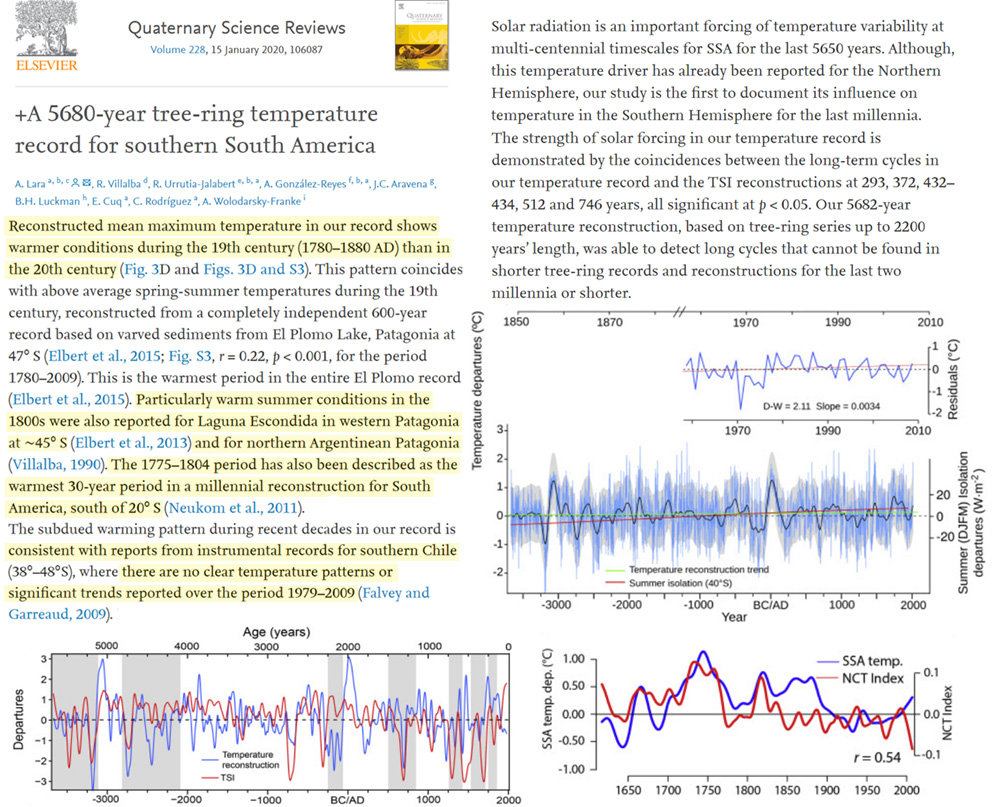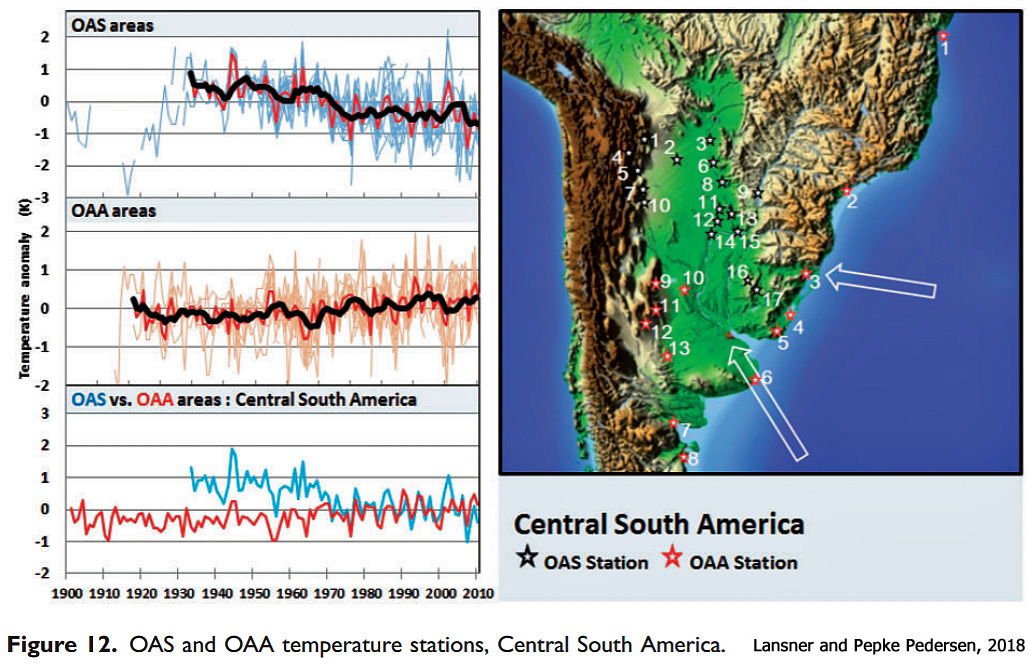A new 5680-year tree-ring temperature reconstruction for southern South America (Lara et al., 2020) reveals (a) no clear warming trend in recent decades, and (b) the 18th and 19th centuries (and many centennial-scale periods from the last 5680 years) had much warmer temperatures than today.

Image Source: Lara et al., 2020
In addition to finding modern temperature changes in southern South America fall well within the range of natural variability in the context of the last 5680 years, Lara et al. (2020) assess solar forcing to have contributed to climate variations for this region of the Southern Hemisphere.
The authors find CO2 fertilization can explain trees’ improved water use efficiency and tree-ring growth in general; this affects the capacity for tree-rings to be a proxy for long-term temperature variability.
They emphasize this composite tree-ring record is “the longest in the Southern Hemisphere.”
Lara et al., 2020
“The most outstanding features in the reconstruction presented here are two major warm periods between 3140–2800 BC and 70 BC – 150 AD (5159–4819 and 2089–1869 years ago, respectively, counted from 2019 to facilitate comparisons with glacier records based on 10Be dated moraines). During these warm periods, no glacier advances have been reported for Patagonia (Aniya, 2013; Kaplan et al., 2016; Strelin et al., 2014, Fig. 5A).”
“Reconstructed mean maximum temperature in our record shows warmer conditions during the 19th century (1780–1880 AD) than in the 20th century (Fig. 3D and Figs. 3D and S3). This pattern coincides with above average spring-summer temperatures during the 19th century, reconstructed from a completely independent 600-year record based on varved sediments from El Plomo Lake, Patagonia at 47° S (Elbert et al., 2015; Fig. S3, r = 0.22, p < 0.001, for the period 1780–2009). This is the warmest period in the entire El Plomo record (Elbert et al., 2015). Particularly warm summer conditions in the 1800s were also reported for Laguna Escondida in western Patagonia at ∼45° S (Elbert et al., 2013) and for northern Argentinean Patagonia (Villalba, 1990). The 1775–1804 period has also been described as the warmest 30-year period in a millennial reconstruction for South America, south of 20° S (Neukom et al., 2011).”
“The subdued warming pattern during recent decades in our record is consistent with reports from instrumental records for southern Chile (38°–48°S), where there are no clear temperature patterns or significant trends reported over the period 1979–2009 (Falvey and Garreaud, 2009).”
Consistent with the patterns documented in this paper, low frequency reconstructed cold temperature anomalies for the NH and periods of minimal solar activity were variable with periods of coincidences and discrepancies during the last 1200 years (Anchukaitis et al., 2017). Changes in large scale NH circulation are thought to provide a possible mechanism for these differences (Anchukaitis et al., 2017). The two major periods with positive anomalies in our reconstruction (3140–2800 BC and 70 BC-150 AD), coincide with positive anomalies of solar irradiance, but the deviations in the TSI are proportionally smaller in the latter period (Fig. 5A).
“A strong CO2 fertilization effect has been the main explanation for the significant increase in water-use efficiency (WUE) reported for Northern Hemisphere temperate and boreal forests over the recent two decades (Keenan et al., 2013).”
“The increasing growth trend and decreasing isotope discrimination in Fitzroya have been attributed to a raise in photosynthetic rates, which has been caused by increased CO2 and/or higher surface radiation, the latter associated with a reduction in cloudiness in a high precipitation area (Urrutia-Jalabert et al., 2015a). In the eastern slope of the northern Patagonian Andes, Argentina, under lower rainfall and cloudiness than in the Chilean western slope, a marked increase in Fitzroya tree-ring growth during the 20th century has also been recorded and attributed to increased CO2 concentration (Lavergne et al., 2018). The coincident Fitzroya growth patterns in two areas of contrasting cloud cover is an additional support for the attribution of CO2 fertilization in this species.”
For good measure, Lara et al., (2020) point out that “a cooling trend has been reported along the Pacific coast (17° – 37° S) of South America for the periods 1979–2006 and 1981–2012 (Falvey and Garreaud, 2009; Hartmann et al., 2013).”
This cooling record is consistent with instrumental records from the dozens of temperature stations all across the central and southern regions of South America which also show cooling/no warming in recent decades (Lansner and Pepke-Pedersen, 2018).






Tree rings are useful for many purposes, but not for estimating temperature. There are simply too many factors influencing the growth. Maybe in some very special circumstances could temperature be divined.
For 10 years, central Chile has been gripped by unrelenting drought. With 30% less rainfall than normal, verdant landscapes have withered, reservoirs are low, and more than 100,000 farm animals have died. The dry spell has lasted so long that researchers are calling it a “megadrought,” rivaling dry stretches centuries ago. It’s not so different from the decadelong drought that California, some 8000 kilometers away, endured until this year.
By analyzing tree ring records, scientists have now found evidence that such tandem droughts are more than a coincidence: They are surprisingly common over the past 1200 years, and they may often share a common cause—an abnormally cool state of the eastern Pacific Ocean known as La Niña. “We did not expect there to be as much coherence as we see,” says Nathan Steiger, a paleoclimatologist at Columbia University who presented the work this month at a meeting of the American Geophysical Union. “They just happen together.” The results suggest that, in the future, extreme aridity could strike all along the Americas’ western coast.
Evidence for synchronous, hemispherewide droughts first emerged in a 1994 study in Nature, which documented dead tree stumps in the middle of lakes and rivers in both Patagonia and California’s Sierra Nevada. For trees to grow in stream- and lakebeds, the droughts must have lasted for decades, and at least one of these megadroughts seemed to have hit both continents simultaneously.
https://www.sciencemag.org/news/2019/12/warning-ancient-tree-rings-americas-are-prone-catastrophic-simultaneous-droughts
California has not been innduring a drought. The “drought” is the intersection of growing demands and a comparatively unchanging water supply. You can acquire and analyze statewide rainfall data from 1895 to the present from http://www.wrcc.dri.edu. There are no significant droughts in the data longer than ca. 2 – 3 years, if you want to call them that and two the three wettest years in recorded rainfall come after AD 2000. Also, over the last century there is no statistically significant trend in rainfall in California. Trend inclination tends to change annually depending on the amount of rain. Drier than normal years yield mildly negative trends while wetter than normal years yield positive trends. In short there are no trends in rain (and snowfall) the last century.
Everything is upside down in the Southern Hemisphere.
Yeah………how do they not fall off?
Tree rings are not an indicator or measure of temperature.
Something I tried to tell Alarmists when they where reporting evidence of modern global warming using tree rings. That was back around the time they pointed to ice core samples as evidence of CO2 causing warming. That was just before careful scientific analysis discovered, which seemed to be overlooked on network and cable news, that Warming preceded increased concentrations of atmospheric CO2. of course that didn’t fit the narrative promoted by the alarmists hence the lack reporting by the media.
Stradivarius built violins from trees that grew during the Little Ice Age, the trees’ growth rings were similar for summer and winter growth rates.
Tree growth rings can indicate a temperature anomaly, to extrapolate temperature from tree rings may have some merit.
Dendrochronology has to have some benefit, reveal something more than tree growth rates and number of years of growth. Sure can tell wet years from dry years.
Mud cores from the ocean floor provide information about past climates from data. Those tiny little animals trapped in the mud do tell a story.
Tree studies, dendrochronology, can’t be feckless, has to have some value.
It wasn’t the weather that made a Stradivarius sound so good, it was minerals that made the violins sound so perfectly toned.
Salted lumber and plywood are fire resistant.
We’re just gonna keep finding the recent (10000yr) past was warmer.
I think some may be interested in this:
https://phzoe.wordpress.com/2020/02/05/pressure-change-and-real-standard-pressure/
[…] https://notrickszone.com/2020/02/03/longest-ever-s-hemisphere-tree-ring-reconstruction-finds-the-170… […]
The very first two lines of the abstract are as follows:
“It is widely documented that the Earth’s surface temperatures have increased in recent decades. However, temperature increment patterns are not uniform around the globe, showing different or even contrasting trends.”
The summary here ignores this key point, instead cherry-picking parts of the paper in what I perceive to be an effort to dispel the scientific consensus that the global surface temperature is, on average, increasing. Local trends can and do of course vary. Does anyone disagree that the results of the paper are being taken out of context in this summary?
[…] https://notrickszone.com/2020/02/03/longest-ever-s-hemisphere-tree-ring-reconstruction-finds-the-170… […]